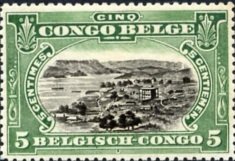Stamp: type 'Mols' bilingual stamps, changed frame (Belgian Congo 1915)
type 'Mols' bilingual stamps, changed frame (Belgian Congo 1915)
01 October (Belgian Congo ) within release Country Symbols goes into circulation Stamp type 'Mols' bilingual stamps, changed frame face value 5 Belgian centime
| Stamp type 'Mols' bilingual stamps, changed frame in catalogues | |
|---|---|
| Michel: | Mi:BE-CD 25 |
| Stamp Number: | Sn:BE-CD 60 |
| Yvert et Tellier: | Yt:BE-CD 64 |
| Belgium: | Bel:BE-CD 64 |
Stamp is horizontal format.
harborAlso in the issue Country Symbols:
- Stamp - type 'Mols' bilingual stamps, changed frame face value 5;
- Stamp - type 'Mols' bilingual stamps, changed frame face value 10;
- Stamp - type 'Mols' bilingual stamps, changed frame, reworked sky face value 10;
- Stamp - type 'Mols' bilingual stamps, changed frame face value 15;
- Stamp - type 'Mols' bilingual stamps, changed frame face value 25;
- Stamp - type 'Mols' bilingual stamps, changed frame face value 40;
- Stamp - type 'Mols' bilingual stamps, changed frame face value 50;
- Stamp - African Elephant (Loxodonta africana) - changed Frame face value 1;
- Stamp - type 'Mols' bilingual stamps, changed frame face value 5;
- Stamp - African Elephant (Loxodonta africana) - New Color face value 1;
- Stamp - Bangala Chief Morangi and Wife - New Color face value 5;
- Stamp - Inkissi Falls - New Frame face value 25;
- Stamp - M'pozo Railway Bridge Bilingual (French-Dutch) - New Color face value 50;
- Stamp - Native Canoe - New Color face value 40;
- Stamp - Oil Palm Trees Bilingual (French-Dutch) - New Color face value 15;
- Stamp - Port of Matadi Bilingual (French-Dutch) - New Frame face value 5;
- Stamp - Stanley Falls Bilingual (French-Dutch) - New Frame face value 10;
Stamp type 'Mols' bilingual stamps, changed frame it reflects the thematic directions:
A landscape is the visible features of an area of land, its landforms and how they integrate with natural or man-made features. A landscape includes the physical elements of geophysically defined landforms such as (ice-capped) mountains, hills, water bodies such as rivers, lakes, ponds and the sea, living elements of land cover including indigenous vegetation, human elements including different forms of land use, buildings and structures, and transitory elements such as lighting and weather conditions. Combining both their physical origins and the cultural overlay of human presence, often created over millennia, landscapes reflect a living synthesis of people and place that is vital to local and national identity. The character of a landscape helps define the self-image of the people who inhabit it and a sense of place that differentiates one region from other regions. It is the dynamic backdrop to people’s lives. Landscape can be as varied as farmland, a landscape park, or wilderness. The earth has a vast range of landscapes, including the icy landscapes of polar regions, mountainous landscapes, vast arid desert landscapes, islands and coastal landscapes, densely forested or wooded landscapes including past boreal forests and tropical rainforests, and agricultural landscapes of temperate and tropical regions.
A port is a maritime facility comprising one or more wharves or loading areas, where ships load and discharge cargo and passengers. Although usually situated on a sea coast or estuary, ports can also be found far inland, such as Hamburg, Manchester and Duluth; these access the sea via rivers or canals. Because of their roles as ports of entry for immigrants as well as soldiers in wartime, many port cities have experienced dramatic multi-ethnic and multicultural changes throughout their histories
Coastal areas are local administrative units (LAUs) that are bordering or close to a coastline. A coastline is defined as the line where land and water surfaces meet (border each other).



